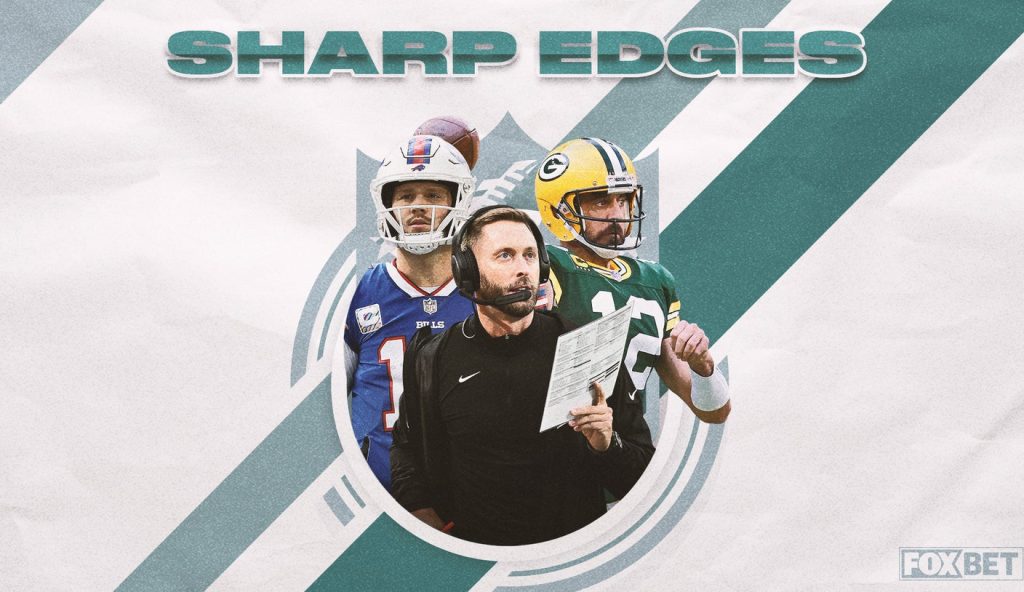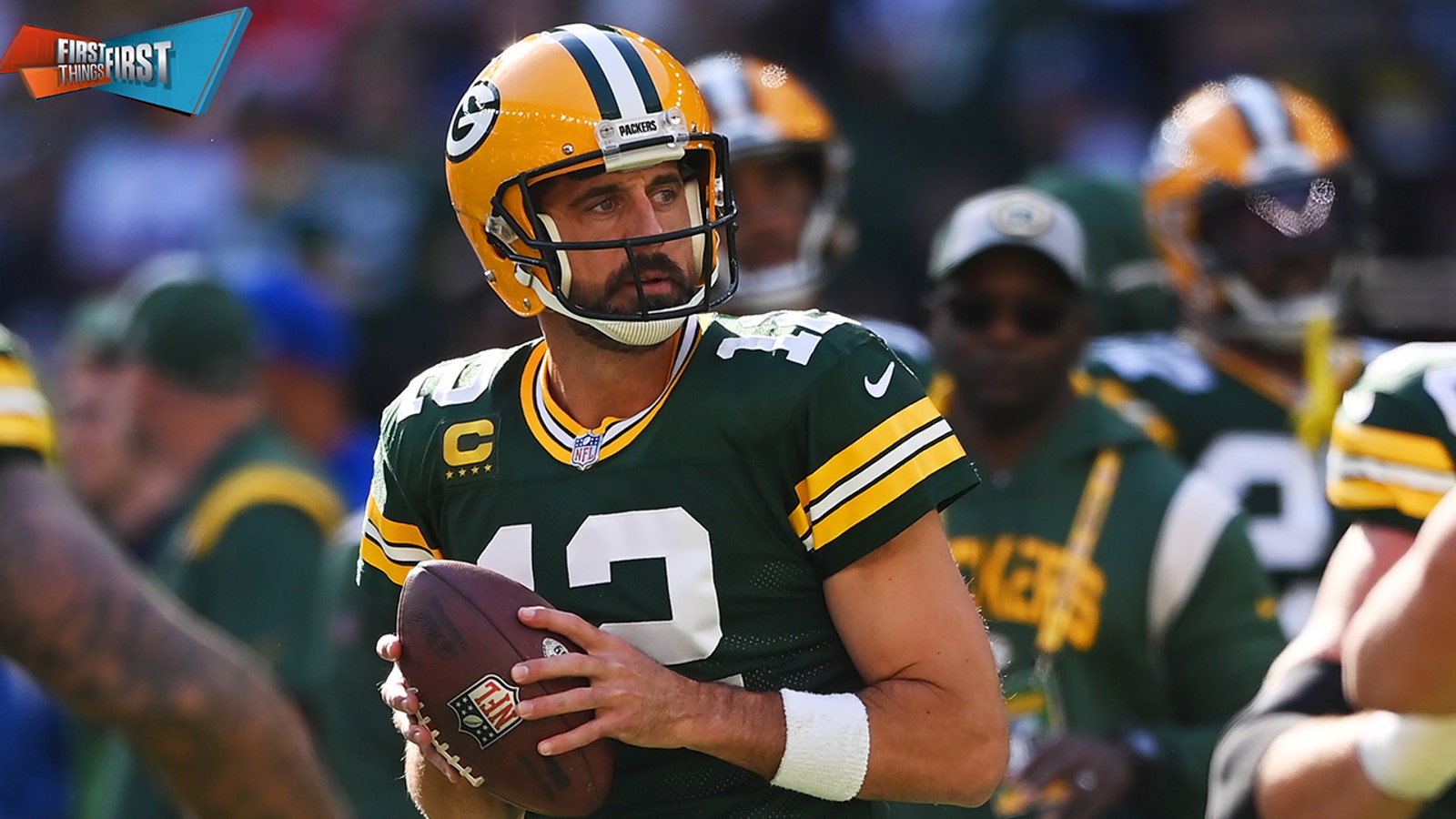Bills air it out; let Kyler Murray cook; where it goes wrong for Packers


By Warren Sharp
FOX Sports NFL Writer
In late September, I wrote in detail about Buffalo’s offense and how, while it was more efficient on a drive basis, the Bills were scoring fewer points early in games due to their lack of explosion in the passing game, their shorter target depth and more frequent third-down attempts.
I stated: “The Ken Dorsey Bills, though they are efficient, have been a far cry from the aggressive and explosive first-half Brian Daboll Bills.”
Buffalo took note and made a massive adjustment against the Steelers on Sunday. The Bills raced to a 31-3 halftime lead, and they did it by throwing deep.
Examine Josh Allen‘s early down air yards in the first half of games:
- Week 1: 2.9
- Week 2: 8.2
- Week 3: 5.2
- Week 4: 2.3
- Week 5: 15.0
This wasn’t just one or two big strikes, either.
On Allen’s 18 early-down attempts in Week 5, he threw 10 of them 12+ yards downfield and six of them more than 20 yards downfield.
In Weeks 1-4, combined, he threw only 17 passes 12-plus yards downfield and threw only six passes more than 20 yards downfield.
Despite the windy day, he matched that number in Week 5 alone.
He hadn’t thrown a single pass 40 or more yards downfield on the season (early downs, first half).
He threw two 50-yarders Sunday.
Next up? The Kansas City Chiefs.
Ironically, scoring points quickly will obviously work to gain a lead, but to hold the lead against the Chiefs, the Bills likely will need to resort to their previous style. That is, in the second half, it will be vital to ensure they are in more manageable third-down distances and capable of converting them.
As we saw Monday night, the only lead that is safe vs. Patrick Mahomes is one where your offense holds the ball and does not surrender it back to the Chiefs.
After all, records when trailing by 10-plus points among active quarterbacks, including the playoffs:
- Mahomes: 12-9 (57.1%)
- Tom Brady: 39-63 (38.2%)
- Russell Wilson: 15-37 (28.8%)
- Lamar Jackson, Jimmy Garoppolo and Jalen Hurts: 4-10 (28.6%)
The Best Cardinals Offense Is One With Less Kliff
A few important numbers to note with regard to the Cardinals’ offense:
Points when coach Kliff Kingsbury is using his script: 0
Kyler Murray rushing attempts this year by half:
- First half: Nine attempts
- Second half: 19 attempts
First-half points, when Murray isn’t running and is executing more of the designed offense: 26
Second-half points, when Murray is using his legs to create more of the offense while Kingsbury is watching: 73
Simply watching the games showcases how much better this offense becomes when Kyler Murray is scrambling to pass the ball out of rhythm of the offense, as well as when he’s scrambling to run the ball.
We’ll see how this looks when DeAndre Hopkins returns. But for now, the Cardinals (2-3) have a defense that cannot be relied upon to win games. It’s the offense, as we thought and predicted entering the season, that must win games for this team.
The offense goes as far as Murray can take them. I’ve been highly unimpressed by Kingsbury, and it’s not just this year. It’s no secret this offense returns to earth and the Cardinals lose games late in the year, predominantly after Murray gets injured, which seems to happen midway through every season.
So long as the QB is healthy, the Cardinals stand their best chance of winning games by relying more on his ability to create the offense in the first half, rather than on Kingsbury to design it.
Flags Fly in K.C.
We all saw it: the terrible flag for roughing the passer against Chris Jones. Not only should it not have been thrown, the penalty negated a clear and obvious fumble that Jones himself recovered.
The crowd let the refs have it, big time.
And from that point in the game onward, flags continued to play a major impact.
That play occurred with 1:07 left in the first half. The Raiders kept the ball and kicked a field goal half-a-minute later.
With 17 seconds left in the first half, the Chiefs had the ball on their own 25-yard line. An obvious face mask gave the Chiefs 15 more yards to allow them to attempt a 59-yard field goal to end the first half. They made it. Keep in mind, they won by only one point.
The flag should have been thrown. But as is the point the rest of the game, there are potential penalties that occur literally on every play in the NFL. It all depends on how close and what you want to call.
Here’s the bottom line:
In the final 30 minutes and 17 seconds of the game, the Raiders lost 10.1 expected points on seven penalties.
Over that same span, the Chiefs lost just 1.1 expected points on only two penalties.
That’s nine expected points in favor of the Chiefs.
Prior to that point? Three penalties on the Raiders and three penalties on the Chiefs.
The Raiders gained 7.2 expected points on the three Chiefs penalties while K.C. gained 4.1 expected points on the Raiders’ penalties.
It was clear, in the second half, the Chiefs had the edge in called penalties. But the first half was called extremely balanced.
Matt Rhule Is Fired
Just one week ago, I called Matt Rhule the worst coach in the NFL.
Sure, there are other coaches who are bad. But I believe strongly in the power of expectations.
None of the other coaches in the NFL failed to meet expectations like Matt Rhule did.
As I stated: Rhule has covered the spread at the NFL’s lowest rate of any head coach since he entered the league in 2020. That means that although we know his teams haven’t been the greatest, his quarterbacks had issues, and we’ve had terribly low expectations for his teams, he still couldn’t even meet these already ground-floor expectations.
His plan of attack was flawed from the beginning. He thought he could shortcut the NFL by hiring QBs who failed elsewhere. He thought he could fix them. He was wrong. And now he is fired.
This gives us an excellent opportunity to share some thoughts on building rosters.
There is one shortcut the NFL provides and that’s having a quarterback on a cheap, cost-controlled rookie deal.
He might go through growing pains his first year in the NFL. But by year two, three and four, he’s often performing at a level well above his pay grade. And that’s the edge.
Getting more than what you paid for. And there’s a cheat code for players on their rookie contracts.
Unless you have a generational talent, such as Patrick Mahomes or Tom Brady or Josh Allen, who can still prove their worth while occupying a massive cap hit, you are NOT going to win in the NFL with a regular veteran QB making good money.
Because you’re competing against both teams with great QBs on rookie deals and generational QBs. And this is a quarterback-driven league.
So, it’s vital for coaches to understand this concept when building teams. There’s a reason why teams like the Colts, the Commanders and several others cannot get over the hump. Recycled QBs rarely win.
The Rams got super lucky last season. That was an exception to the rule. And we can see this year how much worse a very similar roster is performing. Six weeks into the season, and this Rams team will need a win over the Rhule-less Panthers just to get back to .500.
Packers Offense Seems Lost But is Better Than It Looks
I don’t know what the Green Bay offense was doing in London.
Green Bay faced a predictably blitz-happy Wink Martindale-led Giants defense. And it looked surprised when the defense blitzed at a high rate.
The Packers jumped out to a big lead and the defense surrendered it while the offense couldn’t sustain offense.
Aaron Rodgers, Packers blow double-digit lead
Nick Wright, Chris Broussard, Kevin Wildes and Greg Jennings discuss the Packers blowing a double-digit halftime lead to Daniel Jones, Saquon Barkley and the Giants.
However, in Week 5, the only offenses who gained first downs on early downs more than the Packers were the Browns and the Chargers in that back-and-forth, high-scoring affair.
And what you might not know about the Packers’ offense, considering some of their struggles which have them sitting at 3-2, is that this season, the Packers are the NFL’s No. 1 early down offense in the first three quarters of games.
They both convert first downs on early downs at the highest rate and third downs make up the lowest rate of total snaps on offense.
Look at the rate of offensive drives that make it into the red zone for the Packers, by quarter:
- First quarter: 54% (No. 3 in NFL)
- Second quarter: 29% (No. 11 in NFL)
- Third quarter: 15% (No. 29 in NFL)
- Fourth quarter: 31% (No. 11 in NFL)
They continue to get less and less aggressive, calling more and more conservative offense over the course of the game, until at last they have to try to secure the win in the fourth quarter.
Examine the rate of early downs that convert a new set of downs, by quarter:
- First quarter: 23% (No. 18 in NFL)
- Second quarter: 37% (No. 2 in NFL)
- Third quarter: 35% (No. 1 in NFL)
And next, examine their third-down conversion rate, by quarter:
- First quarter: 50% (No. 7 in NFL) – 7.7 yards-to-go on avg
- Second quarter: 40% (No. 15 in NFL) – 6.1 yards-to-go on avg
- Third quarter: 20% (No. 30 in NFL) – 6.6 yards-to-go on avg
It is perplexing that this team, which is so incredible at bypassing third downs in the second and third quarters, declines so badly in their third-down conversion rate in the second and third quarters. Especially when they are seventh-best at converting them in the first quarter despite substantially longer to-go distance. And their average distance to-go is shorter-than-average on these third downs in the second and third quarters (NFL average distance to-go on third down is 6.9 yards, and the Packers average shorter-than-average in both the second and third quarters).
If we dig deeper, we might uncover something that is factoring into their struggles on third downs after the first quarter:
On third downs in the first quarter of games, Aaron Rodgers is facing man or zone at about the same rate (five dropbacks vs. man, seven vs. zone). His air yards per attempt is quite similar (5.75 air yards vs. man, 7.0 air yards vs. zone). And he’s converting 50% of these third-down passes combined.
But after the first quarter, his target depth on third downs based on coverage is wild:
- Vs. man: 12.8 air yards on 10 dropbacks despite 6.6 yards-to-go, 50% of att thrown beyond sticks
- Vs. zone: 1.9 air yards on 9 dropbacks, despite 7.8 yards-to-go, 11% of att thrown beyond sticks
It’s no wonder Green Bay is converting just 24% of these third-down attempts into first downs.
Either Rodgers is chucking low-percentage deeper passes, well beyond the sticks (vs. man), or he’s dumping the ball well short of the sticks and expecting his receivers to run for the first down (vs. zone).
Last year, on third downs in the first three quarters vs. man coverage, Rodgers had a 14.0 aDOT, which was No. 2 in the NFL behind only Russell Wilson (NFL average was 9.5).
But he was chucking to his primary receivers deep: Marquez Valdes-Scantling had an aDOT of 19.09 and Davante Adams had an aDOT of 12.7. Every other receiver was less than that.
Rodgers no longer has Adams or MVS to trust on deeper passes downfield on third down.
Look at his third-down targets vs man coverage this year in the first three quarters:
- Allen Lazard: Six targets, 17.5 aDOT
- Aaron Jones: Three targets, 4.7 aDOT
- Robert Tonyan: Two targets, 1.0 aDOT
- Romeo Doubs: One target, 1.0 aDOT
Meanwhile, vs. zone, Rodgers hasn’t thrown a single target to Lazard, and Randall Cobb is his primary target (who saw zero targets vs. man coverage).
This third-down offense right now is too predictable based on coverage. It can be fixed, and considering how good Green Bay is on early downs, look out for this Packers offense.
But right now, it’s the third-down offense that is holding this team back.
Warren Sharp is an NFL analyst for FOX Sports. He is the founder of Sharp Football Analysis and has worked as a consultant for league franchises while also previously contributing to ESPN and The Ringer, among other outlets. He studied engineering before using his statistical acumen to create predictive football models. You can follow Warren on Twitter at @SharpFootball.

Get more from National Football League Follow your favorites to get information about games, news and more









